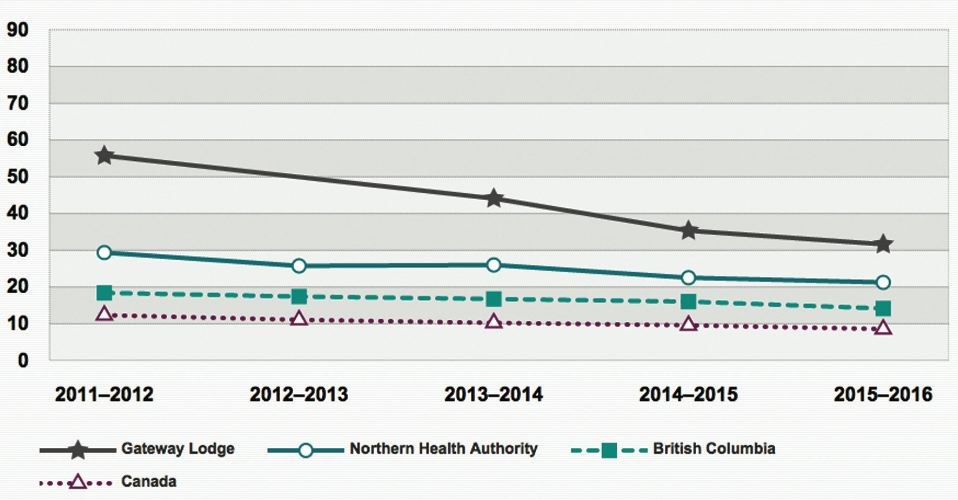Residents in long-term care facilities within Northern Health are experiencing moderate to excruciating pain at more than twice the national average, according to a Canadian Institute for Health Information (CIHI) report.
The number rises to more than three times the national average at Gateway Lodge in Prince George and more than five times the Canadian average at Kitimat Hospital and Health Centre.
The national average is 8.5 per cent, while the B.C. average is 14.1. Northern Health sits at 21.2 per cent.
Gateway Lodge reports resident experiencing pain at 31.6 per cent and Kitimat Hospital and Health Centre is at 44.7 per cent in 2015-16.
Residents in long term care facilities throughout Canada are assessed on a quarterly basis using a comprehensive standardized guide called the RAI or resident assessment instrument, from which 100 elements are used to create a comprehensive profile. A coding manual is provided to all institutions to use through the assessment process.
Coding for pain is as follows:
0, No pain.
1, Pain less than daily.
2, Pain daily.
To determine intensity of pain as described or manifested by the resident, the codes include:
1, Mild pain, although resident experiences some ("a little") pain he or she is usually able to carry on with daily routines, socialization or sleep.
2, Moderate pain - resident experiences "a medium" amount of pain.
3, Times when pain is horrible or excruciating - worst possible pain. Pain of this type usually interferes with daily routines, socialization and sleep.
The report includes reports from 2011-12 to 2015-16 and offers health authorities a perspective on what their numbers are and also offers a comparative view as well.
"There is a lot more information that homes have access to in a private reporting environment," Connie Paris, manager of home and continuing care data management at CIHI, said.
The CIHI report provides only a few key indicators, she added.
"Then you can look at it from more of a system perspective," Paris said. "And it does give us the capability of being able to drill down to even the facility level for the experience indicators."
Calculations for those experiencing pain in long term care facilities is reported as a percentage. If there are 100 residents in the facility and 10 experience moderate pain daily or any episode of excruciating pain then the unadjusted raw rate is 10 per cent, Paris explained.
What is presented in the report is a risk-adjusted version, factoring in cognitive impairments and the number of residents in a facility with those issues.
She said each facility needs to look at the residents that are experiencing pain and ask what's going on.
"When you are looking inwardly, you need to look at unadjusted numbers," Paris said.
When looking at the report with the risk-adjusted numbers. That's something else.
"That's really only to say 'Hey, there's a flag going up here,' something doesn't look quite right when I see how I compare to others," Paris said.
Several Northern Health facilities were on par with the national average, but most were well above the average with Gateway and Kitimat at the high end.
"The other thing I see here with Northern Health is that there is quite a bit of variation," Paris said.
"So that's another thing to look at is such a variation within a region and to say OK, why does it look so good over here and not as good over at this end. What's that difference there that we're not risk-adjusting for - so what's happening outside that risk adjustment piece that's causing that difference in what we're seeing.'"
Paris said if facilities numbers don't make sense to them, the health authority needs to make sure the coding is being done correctly because it's important that everyone is being judged by the same yard stick.
"So one of the first things that we say is go back and look at the coding guidelines and make sure front-line staff who are capturing this information are clear on how that's collected because you have to understand and trust a number before you can say, 'Is this a practice problem or a data quality issue.'"
The numbers seen in the report are indicators but don't tell the whole story at Gateway Lodge.
Gateway Lodge has a special care unit housing 14 residents who are extremely cognitively impaired. It's the only special care unit of its kind in Northern Health.
"What the risk-adjusted number is saying is that even though we've taken into account the fact that you have a certain percentage of the population with advanced cognitive impairment, you're still looking high," Paris said about Gateway Lodge.
"The idea of CIHI putting this information out into the public domain is certainly not to point fingers or to single out the poor performers."
It is an opportunity for organizations to look at information that quickly identifies where there is an issue which can be compared to others, she added.
"The information is put out there with the best of intentions, that the majority of people working in this sector are earnestly and honestly working for the betterment of their residents, and sometimes they just don't know or sometimes they just need a little extra help to figure out where the issues are," Paris said.
"A lot of homes have jumped on that bandwagon and have worked to try to improve a lot of these quality indicators. That's the general trend that this sector is going towards. They are in a lot better shape than they were 10 years ago in terms of comfort and understanding the use of performance measures."



